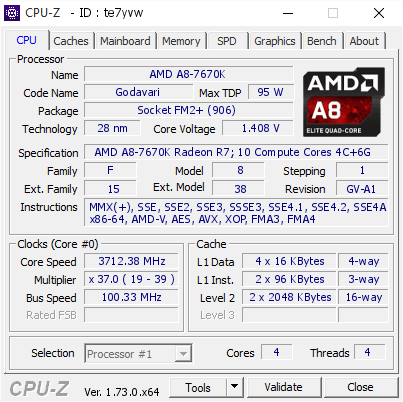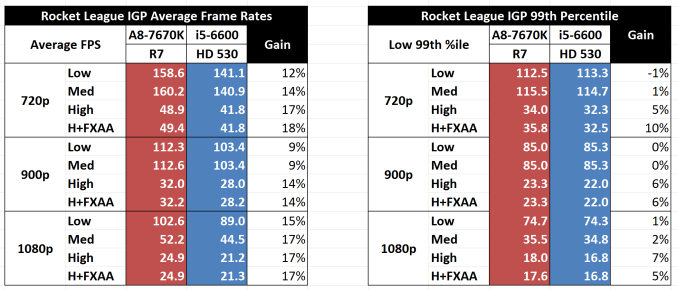The AMD A8-7670K APU Review: Aiming for Rocket League
by Ian Cutress on November 18, 2015 8:00 AM ESTAMD A8-7670K Conclusion
We have tested all of the new AMD APUs as they have trickled into the market, but there are a few obvious points that come up from comments and forums when we discuss them. To start, the base architecture in these APUs, though part of the Kaveri or Kaveri Refresh family, debuted in January 2014, making it nearly two years old. The underlying design that has been iterated upon three times for Kaveri — Bulldozer — is now four years old, released in October 2011. For all intents and purposes, because these processors are AMD’s latest desktop offerings, they are compared to Intel’s latest counterparts.
Despite AMD’s push into using their heterogeneous system architecture platform as a way to accelerate day-to-day tasks that involve any vector calculations (JPEG decode, video playback), as most benchmark workloads will show, the AMD APUs come out slower on the pure CPU aspect, and they're power-hungry due to the 28-nm lithography node on which they are produced (particularly compared to Intel's latest 14-nm node). I was at an event earlier this year where a technology journalist told AMD up front that they considered the 28-nm processors hot and slow, and that users were not likely to be interested in them.
To combat what AMD sees as an pervasive dislike of the platform, AMD has been focusing on three talking points in their marketing message in order to communicate the areas where they believe they have an advantage. This is, by its nature, a bit of a spiel on AMD's part, but at the same time, there are some nuggets of truth in these claims, as illustrated by our benchmark results.
AMD's first talking point is, of course, price. AMD considers their processors very price-competitive, especially for low-cost systems when you consider performance as a function of total system cost. AMD's second talking point is on the power-consumption issue. For some time now, AMD's line has been that they don't believe that most users think about power consumption when gaming, suggesting that for the markets they are targeting, it might not be an issue to begin with. AMD's third talking point is on graphics performance, where AMD believes that their integrated graphics (or dual graphics with an R7 discrete card) will easily win on price and performance, especially for e-sports titles currently favored by budget gamers.
For the validity of AMD's talking points, we can verify Nos. 1 and 3 with our benchmarks, dollar for dollar. Especially when a dual graphics profile for a game exists, the gaming performance will be better for the same price. However, one might argue that relatively few users use a PC just for games, and items such as JavaScript/HTML5 performance for social media interaction is also important, with this being the main barrier low-frequency APUs have to compete against (in comparison to equally priced Intel counterparts). As for talking point No. 2, it's debatable whether users really care about the power consumption of their system during gaming. A personal thought for this would be if the system fans were to spin up, then maybe it would play on the mind, especially if the system is being used to watch a film or play music. But typically, users concerned with this sort of power consumption tend to be over 25 years old and can afford to be more selective with their purchases, as opposed to e-sports gamers on tight budgets. Nevertheless, some users will wholeheartedly disagree.
Ultimately these points lie at the heart of AMD’s dilemma. On one hand, many users will avoid an APU due to specifications or experience, no matter the budget. On the other hand, AMD has a tight space to work in, but there are areas where their APUs hold an edge over Intel's CPUs. The trick for AMD right now is convincing skeptical buyers of this.
If we look beyond today’s review, everyone who cares about CPU performance is hoping that AMD's new microarchitecture in 2016, Zen, allows AMD to catch up to Intel in raw CPU performance. At present, AMD has released slides claiming a 40% increase in IPC for their new design. If AMD can deliver on their performance goals then this should significantly improve their standing as far as x86 CPU performance goes, though this will initially be aimed at the high-performance market. Otherwise for budget users or the e-sports crowd, we will have to wait and see what the Zen microarchitecture brings and how it will be implemented for APUs.
Until then, AMD's APUs still win for that Rocket League style of player, beating any equivalent Intel implementation at the same price. The A8-7670K, with a minor recent discount to $100, is essentially the center point of that APU stack, on AMD's latest process design tweaks. We overclocked our sample to 4.6 GHz, but your mileage may vary.
On a personal note, as you might expect, I build systems for my family. My father, who wanted an audio workstation, had a big enough budget to consider something with many cores and hyperthreading, focusing on low audio latency and a configuration that used software that took advantage of that. I've mentioned in these reviews that I outfitted my 15-year-old cousin-in-law with an APU and a discrete card for a small cheap dual graphics system that probably cost $400 or so. With it, he does school work, talks to his friends and plays a range of MOBA and MMO games without issues. He's rather happy with it.
For future reference, all of our regular benchmark results can also be found in our benchmark engine, Bench.














154 Comments
View All Comments
BurntMyBacon - Thursday, November 19, 2015 - link
@Ian Cutress: "It's never an issue of lack of interest or subversion, just procurement (and ensuring we can communicate with the manufacturer at the point of testing)."[sarcasm]I thought Intel and all other computer hardware manufacturers were required by LAW to send their products to Anandtech for prelaunch approval where Supreme Tech Justice Cutress and his colleagues pronounce life or death on potential products. ;' ) [/sarcasm]
Seriously though, I'd say you are doing fine despite the real world procurement and scheduling issues getting in the way.
flabber - Wednesday, November 18, 2015 - link
I can't agree any more with the point that power consumption is the least of my concerns. While there is a significant difference between a 250W TDP CPU and a 50W TDP CPU, where one would have to factor in the cost of cooling and a PSU, 100W is quite manageable. A 500W PSU is more that adequate for just about any current system. However, I am aware that decreased power consumption is an objective in all consumer products and will be seeing in upcoming computer components. (Ironically for mobile components, my 2009 Blackberry with a 1150mAh battery can still run for a couple days before I need charge it.)My rig is equipped with a A10-5800k (2012) and a year old R9-290X (2013). Everyday tasks, such as using a spreadsheet, word processor, citation management or occasional image editing, can't be improved in any noticeably way. With regard to gaming, I can't be bothered to upgrade the motherboard and CPU to a superior Intel alternative. A few more frames per second won't make a game with poor storyline any better, nor will an enjoyable game become any better.
Pissedoffyouth - Thursday, November 19, 2015 - link
If you have 5800 you should look at getting a kaveri for better performance and lower power consumptionGadgety - Thursday, November 19, 2015 - link
"AMD's first talking point is, of course, price. AMD considers their processors very price-competitive"No kidding, I got the A8-7600 for my kid and it's integrated graphics is comparable to the i7 Iris Pro, where the i7 is 5x more expensive. So for 20% of the price we get to enjoy graphics galore. Put it on Asrock's A88X M-ITX motherboard and it outputs 4K cinema. No graphics card means it's compact so we use a tiny chassis, perfect HTPC, and useable for the type of light gaming the kids do.
Gadgety - Thursday, November 19, 2015 - link
@Ian Cutress The performance parity, and sometimes superiority, of the A8-7670k compared to the A10-7850k, and also to the A10-7870k, I guess could be attributable to driver improvements. Did you use the same drivers, or updated versions? If it's improved drivers, this would likely also improve across the APU-range.Ian Cutress - Thursday, November 19, 2015 - link
Same drivers for each. I lock a set of drivers down every test-bed refresh, so in this case it would be 15.4 beta, which is getting a bit old now. Kaveri Refresh does have some minor internal improvements as well I imagine, internal bus frequencies perhaps. There's always a small amount of volatility in the benchmark, depending on what heat density or board issue you might have. Looking back, we haven't always used the same motherboard on the APUs just due to timing (but all A88X), and even though we do some overriding on power profiles it can be difficult to compensate for motherboard manufacturer non-user exposed firmware optimisations on the memory buses.Come the next year test-bed refresh (with DX12 relevant titles hopefully), I'll be going back and redoing them all. That should clear out the cobwebs on the latest drivers and updates, providing a new base.
milli - Thursday, November 19, 2015 - link
Ian Cutress, how is the review of your grandparents laptop coming along? :)I'm waiting for that Carrizo review.
zlandar - Thursday, November 19, 2015 - link
I don't see the point of being so cheap that you are unwilling to spend more for a superior i3-5 and discrete video card. Why would you chain yourself to a dead-end cpu/gpu integrated combo and motherboard that isn't very good to start with?Plenty of people have pointed out how well Intel's cpu have held up since Sandy Bridge. I'm still using a 2600k and have upgraded my video card 3 times. If you are on a tight gaming budget it makes alot more sense to buy 2nd-3rd tier last gen video cards coupled with a good cpu you don't need to upgrade.
BurntMyBacon - Thursday, November 19, 2015 - link
@zlandar "Why would you chain yourself to a dead-end cpu/gpu integrated combo and motherboard that isn't very good to start with?"Aren't just about all laptops deadend with respect to CPU/GPU? (Particularly in the Carrizo price range)
Ton's of laptops are sold without discrete GPUs and no option to upgrade. Why should this matter to a Carrizo review (clearly laptop in this request)?
Ian Cutress - Thursday, November 19, 2015 - link
Something special in the works. After SC15 finishes, I'll be digesting the mountain of data I have. :)